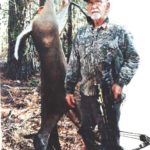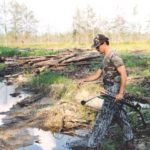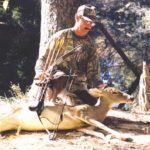
Crossbows have opened up tiny tracts near subdivisions to venison-hungry hunters.
Pelayo was ahead of me on the trail as we trudged back to his truck. It looked like two, maybe three squirrels hanging from his belt. Then the trail made a bend, and I lost sight of him.
About a minute went by, and suddenly I saw him loping back in my direction, holding his hat, and the squirrels flapping crazily around his waist as he sprinted and waved.
“Cops!” he yelled from about 50 yards out, while pointing behind him. Pelayo seemed flustered.
I waited until he reached me, wild-eyed, panting and red faced.
“So what?” I said. “Can’t be for us.”
“Hah!” Pelayo gasped. “Go see for yourself! They got two cop cars, with lights flashing parked next to my truck. A couple of ’em are standing around talking with some people. I ducked just in time. Don’t think they saw me.”
“So WHAT!?” I said again. “The squirrel season’s open. We got permission to hunt this property. We’re not in any city, township or village limits. We were well over 500 feet from any road or habitation while hunting. Everything’s cool. Let’s go out there and see what all the fuss is about.”
“YOU GO!” Pelayo gasped, still panting from his run. “YOU go out there. I’m making a run for it!”
“Calm down, man,” I countered. “They got your truck’s license number and everything. Maybe they’ll tow it in. They’ll track you down for sure!”
“You never know,” Pelayo said. “Come on, let’s make a run for it — for ol’ times sake if nothing else.”
Now here, Pelayo had a point. Indeed, this hunt was itself a sort of “ol’ times sake” endeavor. For three weekends, we’d been sitting in trees with our bows, waiting for deer to amble by while surrounded by swarms of squirrels, who seemed to recognize bows and thus know they were safe. They scampered on branches to within yards of us and flicked their tails, seeming to snicker.
We finally got tired of it and decided to go after the squirrels themselves on this weekend, like we all used to do in the late ’60s, ’70s and ’80s, before deer-mania took over. And we had a blast. From my own belt hung three squirrels, one a beautiful big Bachman’s fox squirrel with the white nose and tail, the kind we’d lovingly skin as young hoodlums then salt-dry the hide on a board.
Indeed, two such skins (dating from a time when Fat City featured discos rather than crack-dens, but holding up splendidly) still serve as drink coasters in my “office.” For elegant dinner parties where I strive for a funky and eclectic décor, I always transport them to the antique coffee table in the den, where they serve as foolproof conversation pieces until a few squeals and gasps from some of the guests (invariably Shirley’s friends from the Kayak Club, typically wives of fly fishermen, or often, the fly fishermen themselves) summon my wife, who hastily removes them, with a strenuous eye-roll in my direction. Gradually the flustered flyfisherpersons sit down, dab their noses and foreheads, finish fanning themselves with their hankies and recover from their fits of the vapors.
At any rate, Pelayo had a point. I nodded and followed him, jogging through the brambles. Ah yes, run for it, like in the (really) good ol’ days, the late ’60s and early ’70s.
As I raced down the trail, the mangled squirrels splattering my pants with blood, the memories started flashing forth: There he is huddled in the briars of a recently sold pasture quickly converting to a subdivision in the Kenner/Metairie area. Slifft! Pop! That gratifying pop meant a head hit from my trusty .177-caliber pellet, propelled by 10 pumps from a Benjamin. The rabbit starts flipping. I race over, grab him by the legs and lift toward Pelayo as he still kicks. But Pelayo is distracted, oblivious to my showing-off.
Suddenly, Pelayo jerks his head, and I notice a cloud of dust on the shell road behind us.
“COPS!” he screeches.
And we race into the briars in a blur, two other rabbits bouncing from strings on our belts. Before Harry Lee, JPs were loath to give much of a chase. Briars always deterred them. We’d race through the thickest patches, lacerating every square inch of exposed flesh but knowing that the cops would stop after a token effort.
“Yep. there they go,”
We’d wait another half hour, then slink back to the bikes. We’d dissemble the Benjamins, and put them along with the rabbits in an oyster sack, lash it to the banana handlebars on our Stingrays, and pedal home like Caesar returning from Gaul.
But not always.
“Whatcha got in those sacks, boys?”
“What? Oh Lord!”
A cop car was behind us on a then-obscured shell road known on some battered signs as West Esplanade.
“Um … um … um … groceries!” I’d stutter.
“Groceries, huh!” the cop would laugh while looking over at his partner in the passenger seat. “Well, let’s have a look.”
“Yeah,” Pelayo would interject. “Just groceries. Were going home to make a stew.”
Pelayo was good at this, no stuttering, a pleasant smile. “My mom isn’t feeling well.”
Now he’d affect a heart-rending pout.
“She works so hard raising us. The least we can do is help out. It’s a small gesture officer, but we offered to get the stuff for the stew ourselves.”
At confession the following Friday we’d have to confer with the priest to determine if these statements qualified as lies. And if they did, whether they were venial or mortal ones. We were, in fact, bringing home the makings of a stew.
Ah, to be 13 again.
This run didn’t last long, however. We stopped after a hundred yards or so, panting furiously, shrugged and decided to take my original advice. After all, we were perfectly legal, as we explained back at Pelayo’s truck both to the cops and to the elegant couple who had summoned them.
They were recent residents to area, from a more urban setting. They’d heard our shots, and immediately called the sheriff’s department. After clarifications from all sides, we parted amicably, especially after Pelayo and I agreed to lay off the shotgunning in the area behind their house — though it was perfectly legal.
Why push it, we reasoned? We hunters surely don’t need any more enemies, however deluded they might be.
The following week, I was back in the same area with a bow and my Dad with his crossbow, back on our deerstands and overlooking piles of corn.
My scouting in this area had actually started the previous summer when I stomped the brakes and swerved onto the shoulder in a blaze of dust, flying gravel and shrieking women.
“AAHHH! Humberto!” Shirley yelled as her Coke splashed across the dashboard joined by her french fries. “Are you out of your mind? What on earth is wrong with you?!”
But my eyes were locked on the corner of a select-cut woodlot across the road. Three deer stared back at me from the far corner. They’d been oblivious to the traffic, munching contentedly on the lush, green browse already sprouting. But boy — just let a car stop!
Those heads pop up instantly. Whoops! Then the ears spring up, then one flicks the tail, then the other flicks — then they bolt!
I started asking around, and learned that these 120 acres were owned by a friend of a friend of an acquaintance. I got this Mr. McKee’s phone number, and rang him up, mentioning our mutual friends as references. Then I paid a courtesy call. Then another. Then another featuring fresh redfish fillets.
My neighborhood “lease” was granted with a smile and a handshake.
No foodplots and camp and ATVs and all the attendant hoopla on this “lease,” but this was for easy, convenient weekday hunts. And heck, Mr. McKee was happy to have my visible presence on his property. It kept the dumpers, litterers and dope fiends away.
From St. Francisville around to Denham Springs and eastward through Hammond, Mandeville to Slidell, it’s becoming all too familiar — strip malls and subdivisions sprouting like mushrooms after a rain, with many hunters losing their leases or portions of their leases as a result. And with many ugly incidents between the new residents to these quasi-rural subdivisions and people hunting in the vicinity.
Bowhunting provides an accommodation to this problem. But we’re all friends here, so let’s come out and admit it: For most people, a bow is a pretty inefficient tool for cleanly killing and quickly finding a shot deer. There, I said it.
I know, I know, some people are experts at the game and pride themselves on the hunting skills, marksmanship, etc. etc., required of consistently killing deer with a bow.
Great, I salute them. More power to ’em. But then there’s the rest of us — the vast majority. I strongly suspect the number of arrow-stuck but lost deer is much higher than most of us like to admit. And I know many hunters who’ve given up bowhunting entirely because of one or several such gut-wrenching episodes.
Besides my own observations, the LDWF reports fewer than 30,000 bow licenses sold last year, a figure that’s been steadily declining year by year. Compare this to the 145,000 for gun hunters.
Thus allowing crossbows for all hunters, as promulgated by the LDWF this year, strikes me as an absolutely splendid move. My father has used one for years along with Pelayo (due to a physical handicap which made drawing a bow impossible). Neither of these crossbow hunters has ever hit a deer and then lost it.(Wish I could claim the same with my bow, even though I practice often and have never taken a shot over 23 yards.)
In fact, I’ve been involved in the “tracking”of most of Dad’s and Pelayo’s deer, and have never seen one go much over 60 yards. For whatever reason, with a crossbow-powered arrow through the vitals (lungs typically), they drop more quickly than many of the deer we blast through the heart or lungs (missing neck and spine) with a 150-grain soft point from a .30-06! I kid you not.
You aim a little too far forward with a crossbow, and hit the shoulder bone — no problemo. The arrow blasts right through to the vitals. Neck and spine hits mean instant drops.
I say crossbows will get more people (especially youngsters) hunting. Not many have the time (or patience or inclination) for the hours of target-practice and bow-tuning required for consistently successful bowhunting.
About 20 years ago, timber prices jumped, and it seemed that every patch of woods in Southeast Louisiana was logged — or at least select cut. Then sure enough, up sprouted all that underbrush to the delight of deer.
Considering that much of this was in primarily pine wooded areas with relatively low deer densities per acre (compared to bottomland hardwood areas), this logging created some pretty decent deer hunting in previously lousy areas. That most of the logging involved large pines and (perhaps keeping in mind the future residential value of these ares) most of the oaks remained helped even more.
This is precisely what occurred on Mr. McKee’s land: formerly pine-canopied with a couple deer, now lush with privet, french mulberry, smilax, blackberry and dotted with mature red and water oaks — and attracting deer from the surrounding areas that remained predominately mature pine.
Given this unwitting boost as deer habitat by logging crews, many of these small patches (too small to lease profitably) hold more deer per acre than the huge paper-company tracts. Also, all that land clearing and development keeps pushing the deer into ever smaller parcels, creating even higher deer-densities.
A major drawback is that semi-suburban deer are even more infuriatingly nocturnal than the already infuriating norm for Southeast Louisiana deer, which is saying something.
On the upside, these semi-suburban “leases” are generally close-by and convenient to hunt. This lets us take advantage of extremely cold or drizzly weekdays, or days during the height of the rut, when the deer will be more active during daylight.
On these days, we start work a little later in the morning, or knock off a little early for an evening hunt. Can’t do this when your only deer-lease is in Woodville or Vidalia, much less Butler, Ala.
I humped up on my climber just off the trail Pelayo and I had fled down the week before during the problematic squirrel hunt. Frost still covered the open areas, and I’d just crunched through a thin ice layer over a puddle. Conditions seemed tops. The sun hadn’t been up 30 minutes, and the cardinals and squirrels were just starting to raid my corn when I saw … what … looked … like — YES!
The shakes started. I already had my bow at semi-ready. So I’d only have to draw and release. But the doe wasn’t quite in range. It was in the thick brambles and downed tree-tops along the branch behind me. Another 10 yards, please!
From the shadows, I couldn’t tell if it was looking at me or away from me. All I saw was the outline of head, neck and ears. No horns. But so what? Why won’t it move? What’s it looking at? Is it looking at me or away from me? Ah, it flicked an ear, must not see me. Now it’s coming closer. She knows this corn pile well. Probably hits it every night. This morning, the chill left her out a bit longer than usual — to my immense gratification.
My knees started shaking. Her head bent down to nip on some privet, and I raised the bow — but held steady. The doe finally ambled to the edge of the corn, and started munching out — almost in range! I drew but couldn’t make it out through the peep sight for some reason.
WHAT!! NO!
My cell phone started ringing in my top pocket! The doe heard it clearly. She raised her head and stared straight at me! Then she bobbed her head a couple times. There she goes! White flag flying! I can’t believe this!
I flipped open the phone in a blind rage.
“WHAT! I almost had one! You screwed up my …. Oh alright. Be right over.”
Sure enough, Dad had shot a doe over corn from his ladder stand. So I finally calmed down. This development took the edge off a bit.
“Looked like a good hit,” he said. “But I’ll wait till you get here to look for it.”
I got there, and the doe hadn’t run fifty yards from where the crossbow arrow smashed through both lungs at 21 yards. Our whooping and high-fiving was probably louder than our shotgun blasts the week before.
But nobody called the cops this time.






